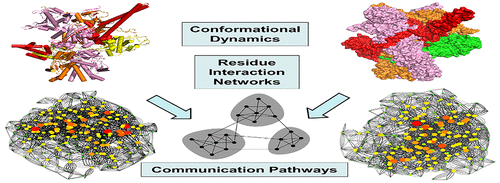当前位置:
X-MOL 学术
›
J. Chem. Inf. Model.
›
论文详情
Our official English website, www.x-mol.net, welcomes your feedback! (Note: you will need to create a separate account there.)
Functional Role and Hierarchy of the Intermolecular Interactions in Binding of Protein Kinase Clients to the Hsp90–Cdc37 Chaperone: Structure-Based Network Modeling of Allosteric Regulation
Journal of Chemical Information and Modeling ( IF 5.6 ) Pub Date : 2018-02-15 00:00:00 , DOI: 10.1021/acs.jcim.7b00638 Gabrielle Stetz 1 , Gennady M. Verkhivker 1, 2
Journal of Chemical Information and Modeling ( IF 5.6 ) Pub Date : 2018-02-15 00:00:00 , DOI: 10.1021/acs.jcim.7b00638 Gabrielle Stetz 1 , Gennady M. Verkhivker 1, 2
Affiliation

|
A fundamental role of the Hsp90–Cdc37 chaperone machinery in mediating conformational development and activation of diverse protein kinase clients is essential for signal transduction. Structural and biochemical studies have demonstrated that characterization of global conformational changes and allosteric interactions in the Hsp90–Cdc37–kinase complexes are central to our understanding of the mechanisms underlying kinase recruitment and processing by the Hsp90–Cdc37 chaperone. The recent cryo-electron microscopy structure of the Hsp90–Cdc37–Cdk4 kinase complex has provided a framework for dissecting regulatory principles underlying differentiation and recruitment of protein kinase clients to the chaperone machinery. In this work, we have characterized functional role and hierarchy of the intermolecular interactions in binding of protein kinase clients to the Hsp90–Cdc37 system. The network analysis revealed important relationships between structural stability, global centrality, and functional significance of regulatory hotspots in chaperone regulation and client recognition. A unique asymmetric topography of the intermolecular communities in the chaperone–kinase complex has quantified a central mediating role of Cdc37 in client recognition and allosteric regulation of the chaperone–kinase complex. Modeling of allosteric pathways in the chaperone complex has further clarified structural and energetic signatures of allosteric hotspots, particularly linking sites of post-translational modifications in Hsp90 with their role in allosteric interactions and client regulation. The results of this integrative computational study are compared with a wide range of structural, biochemical, and cell-based experiments, offering a robust network-centric model of allosteric regulation and client kinase recognition by the Hsp90–Cdc37 chaperone machine.
中文翻译:

在蛋白激酶客户与Hsp90–Cdc37分子伴侣结合中的分子间相互作用的功能作用和层次:基于结构的变构调节网络模型
Hsp90–Cdc37分子伴侣机制在介导构象发展和多种蛋白激酶客户激活中的基本作用对于信号转导至关重要。结构和生化研究表明,Hsp90–Cdc37–激酶复合物中总体构象变化和变构相互作用的表征对于我们理解Hsp90–Cdc37分子伴侣招募和加工的潜在机制至关重要。Hsp90–Cdc37–Cdk4激酶复合物的最新低温电子显微镜结构为剖析将蛋白激酶客户分化和招募到伴侣分子机制的调控原理提供了框架。在这项工作中,我们已经表征了蛋白激酶客户与Hsp90–Cdc37系统结合中分子间相互作用的功能作用和层次。网络分析揭示了结构稳定性,全局中心性以及伴侣伴侣监管和客户认可中监管热点的功能重要性之间的重要关系。分子伴侣-激酶复合物中分子间群落的独特不对称形貌已量化了Cdc37在伴侣分子-伴侣复合物的客户识别和变构调节中的重要中介作用。伴侣复合物中变构途径的建模进一步阐明了变构热点的结构和能量特征,尤其是将Hsp90中翻译后修饰的位点与它们在变构相互作用和客户调节中的作用联系起来。
更新日期:2018-02-15
中文翻译:

在蛋白激酶客户与Hsp90–Cdc37分子伴侣结合中的分子间相互作用的功能作用和层次:基于结构的变构调节网络模型
Hsp90–Cdc37分子伴侣机制在介导构象发展和多种蛋白激酶客户激活中的基本作用对于信号转导至关重要。结构和生化研究表明,Hsp90–Cdc37–激酶复合物中总体构象变化和变构相互作用的表征对于我们理解Hsp90–Cdc37分子伴侣招募和加工的潜在机制至关重要。Hsp90–Cdc37–Cdk4激酶复合物的最新低温电子显微镜结构为剖析将蛋白激酶客户分化和招募到伴侣分子机制的调控原理提供了框架。在这项工作中,我们已经表征了蛋白激酶客户与Hsp90–Cdc37系统结合中分子间相互作用的功能作用和层次。网络分析揭示了结构稳定性,全局中心性以及伴侣伴侣监管和客户认可中监管热点的功能重要性之间的重要关系。分子伴侣-激酶复合物中分子间群落的独特不对称形貌已量化了Cdc37在伴侣分子-伴侣复合物的客户识别和变构调节中的重要中介作用。伴侣复合物中变构途径的建模进一步阐明了变构热点的结构和能量特征,尤其是将Hsp90中翻译后修饰的位点与它们在变构相互作用和客户调节中的作用联系起来。



























 京公网安备 11010802027423号
京公网安备 11010802027423号